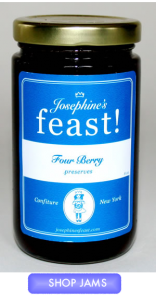Josephine's Feast Jams and Preserves
Preserves or confiture– the word alone evokes the art of the cook who respects and savors the bounty of the season. The best confiteur are sometimes a bit purveyor, a bit cook, a bit chemist, but always an alchemist. “Those who rely on instinct & tradition seem sometimes to surpass the more scientific and more theoretical talents of the professionals.” This is a direct quote from my favor cookbook, “La Bonne Cuisine” by Madame E .Saint-Ange in 1927.
Historically preserves are some of our oldest foods. The Romans learned from the Greeks that quinces slowly cooked with honey would "set" when cool. A Roman cookbook attributed to Apiciusdefrutum—Roman marmalade. Preserves of quince and lemon appear—along with rose, apple, plum and pear—in the Book of Ceremonies by the Byzantine Emperor Constantine VII Porphyrogennetes. Medieval quince preserves, which went by the French name cotignac, produced in a clear version - jelly and a fruit pulp version – preserves. These were often flavored with highly prized spices. In the 17th century La Varenne provided recipes for both thick and clear cotignac. In modern times, preserves were often made by the baker’s or the farmer’s wives as additional income for the family. gives a recipe for preserving whole quinces in a bath of honey diluted with
Preserving great taste can only be achieved by the individually processing of select seasonal ripe fruit in small batches with skill and care no large-scale processor can match. Our commitment is to create the finest preserves with great taste – using only natural apple pectin, pure cane sugar, and local, sustainable, and organic fruits. Try our preserves for breakfast spread on toast or muffins or mixed in oatmeal or yogurt. Dilute with rum or other spirits for a delicious glaze on chops or roasts. A flavorful addition as a condiment on a cheese plate just for fun!
Jams and Preserves
Josephine’s Feast Jams and Preserves
Preserves or confiture– the word alone evokes the art of the cook who respects and savors the bounty of the season. The best confiteur are sometimes a bit purveyor, a bit cook, a bit chemist, but always an alchemist. “Those who rely on instinct & tradition seem sometimes to surpass the more scientific and more theoretical talents of the professionals.” This is a direct quote from my favor cookbook, “La Bonne Cuisine” by Madame E .Saint-Ange in 1927.
 Historically preserves are some of our oldest foods. The Romans learned from the Greeks that quinces slowly cooked with honey would “set” when cool. A Roman cookbook attributed to Apiciusdefrutum—Roman marmalade. Preserves of quince and lemon appear—along with rose, apple, plum and pear—in the Book of Ceremonies by the Byzantine Emperor Constantine VII Porphyrogennetes. Medieval quince preserves, which went by the French name cotignac, produced in a clear version – jelly and a fruit pulp version – preserves. These were often flavored with highly prized spices. In the 17th century La Varenne provided recipes for both thick and clear cotignac. In modern times, preserves were often made by the baker’s or the farmer’s wives as additional income for the family. gives a recipe for preserving whole quinces in a bath of honey diluted with
Historically preserves are some of our oldest foods. The Romans learned from the Greeks that quinces slowly cooked with honey would “set” when cool. A Roman cookbook attributed to Apiciusdefrutum—Roman marmalade. Preserves of quince and lemon appear—along with rose, apple, plum and pear—in the Book of Ceremonies by the Byzantine Emperor Constantine VII Porphyrogennetes. Medieval quince preserves, which went by the French name cotignac, produced in a clear version – jelly and a fruit pulp version – preserves. These were often flavored with highly prized spices. In the 17th century La Varenne provided recipes for both thick and clear cotignac. In modern times, preserves were often made by the baker’s or the farmer’s wives as additional income for the family. gives a recipe for preserving whole quinces in a bath of honey diluted with
Preserving great taste can only be achieved by the individually processing of select seasonal ripe fruit in small batches with skill and care no large-scale processor can match. Our commitment is to create the finest preserves with great taste – using only natural apple pectin, pure cane sugar, and local, sustainable, and organic fruits. Try our preserves for breakfast spread on toast or muffins or mixed in oatmeal or yogurt. Dilute with rum or other spirits for a delicious glaze on chops or roasts. A flavorful addition as a condiment on a cheese plate just for fun!